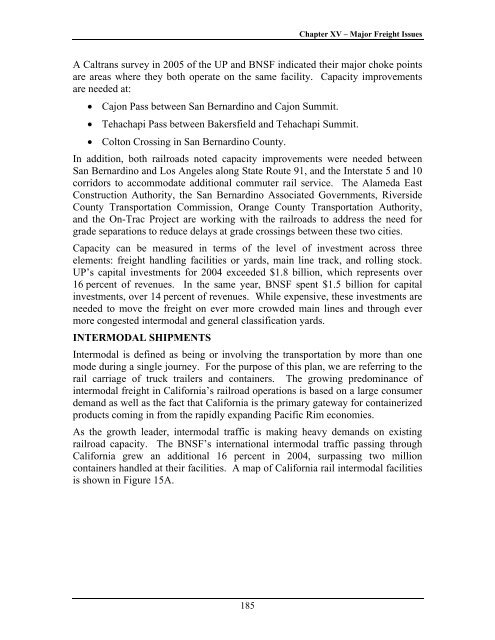California State Rail Plan 2005-06 to 2015-16
California State Rail Plan 2005-06 to 2015-16
California State Rail Plan 2005-06 to 2015-16
You also want an ePaper? Increase the reach of your titles
YUMPU automatically turns print PDFs into web optimized ePapers that Google loves.
Chapter XV – Major Freight Issues<br />
A Caltrans survey in <strong>2005</strong> of the UP and BNSF indicated their major choke points<br />
are areas where they both operate on the same facility. Capacity improvements<br />
are needed at:<br />
• Cajon Pass between San Bernardino and Cajon Summit.<br />
• Tehachapi Pass between Bakersfield and Tehachapi Summit.<br />
• Col<strong>to</strong>n Crossing in San Bernardino County.<br />
In addition, both railroads noted capacity improvements were needed between<br />
San Bernardino and Los Angeles along <strong>State</strong> Route 91, and the Interstate 5 and 10<br />
corridors <strong>to</strong> accommodate additional commuter rail service. The Alameda East<br />
Construction Authority, the San Bernardino Associated Governments, Riverside<br />
County Transportation Commission, Orange County Transportation Authority,<br />
and the On-Trac Project are working with the railroads <strong>to</strong> address the need for<br />
grade separations <strong>to</strong> reduce delays at grade crossings between these two cities.<br />
Capacity can be measured in terms of the level of investment across three<br />
elements: freight handling facilities or yards, main line track, and rolling s<strong>to</strong>ck.<br />
UP’s capital investments for 2004 exceeded $1.8 billion, which represents over<br />
<strong>16</strong> percent of revenues. In the same year, BNSF spent $1.5 billion for capital<br />
investments, over 14 percent of revenues. While expensive, these investments are<br />
needed <strong>to</strong> move the freight on ever more crowded main lines and through ever<br />
more congested intermodal and general classification yards.<br />
INTERMODAL SHIPMENTS<br />
Intermodal is defined as being or involving the transportation by more than one<br />
mode during a single journey. For the purpose of this plan, we are referring <strong>to</strong> the<br />
rail carriage of truck trailers and containers. The growing predominance of<br />
intermodal freight in <strong>California</strong>’s railroad operations is based on a large consumer<br />
demand as well as the fact that <strong>California</strong> is the primary gateway for containerized<br />
products coming in from the rapidly expanding Pacific Rim economies.<br />
As the growth leader, intermodal traffic is making heavy demands on existing<br />
railroad capacity. The BNSF’s international intermodal traffic passing through<br />
<strong>California</strong> grew an additional <strong>16</strong> percent in 2004, surpassing two million<br />
containers handled at their facilities. A map of <strong>California</strong> rail intermodal facilities<br />
is shown in Figure 15A.<br />
185













